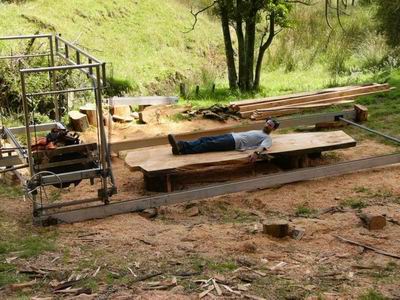Estimating board footage
Most accurate and most accepted methods of figuring BF for lumber. December 17, 2002
Question
I was looking at the Wood Doctor archives and ran across the board foot debate. I was under the impression that a board foot was equal to a 1" thick piece of wood that is 1 square foot in area, thus creating a measure of volume. In that regard, to figure board feet with the equation of thickness x width/12 x length is mathematically correct. The example that Dr. Wengert gives comes out to 9.53 BF.
The only difference I see is that the two were debating on where to round the board footage off. I don't understand why you would want a rounded number in the equation itself, before the whole operation is calculated, therefore multiplying an error further (it doesn't matter if the error is plus or minus - it still gets built in). It seems to me that you would want the more exact number to be used until the problem is solved. Am I correct in this assumption?
Forum Responses
In the real world, a board foot is 1"x1'x1'. But then at the home supply store a 2x4 isn't a 2"x4" piece of lumber.
The problem is that those who went before us have decided the proper way to calculate board footage and we, today, are stuck with that method, like it or not.
Gene Wengert, forum technical advisor
There are many scales for 'estimating' board feet of lumber in logs. That's one thing. Then there is measuring board feet in lumber. That's another thing. And there are different ways to do this, depending on whether you're measuring hardwood or softwood. They say to measure hardwood, you figure the face area of the board and then round off to the nearest half foot. Round up one time and then down the next, figuring that they will balance out somehow. Then when you have all the surface measures done, you multiply the total by the thickness of the lumber. And as softwoods are usually sawn to widths of whole inches, this rounding up and rounding down isn't used. I'm sure if I'm wrong in explaining this, I'll be corrected. I don't do this every day and am recalling something I read here. Wondering if I'm correct…
For hardwoods you are correct, except that when you round, you go to the closest whole number, alternating when the answer is exactly on the 1/2 BF. I think this is what you meant. Also, if less than 1 inch thick, we still use 1.00 as the thickness. Thick is always in 1/4 inch increments. For the length, we use the last full foot. For the width, the actual width in inches and fractions.
For softwoods, we round to the closest 1/100 (or 0.01) BF. We also use the *nominal* size and not the exact size. This means a 2x6x8' that is exactly 1.5 x 5.5 x 8' is 8.00 BF and not 5.50 BF
Gene Wengert, forum technical advisor
If you sell oak 1x4's, then it's more profitable to sell in 8' lengths (counted as 3bf) than as 10' boards (counted as 3bf). Personally, I sell at 2.67bf and 3.33bf independent of the real rules. You get what you pay for and that makes my customers happy.
I do the same thing at my mill. True measurement. I explained that to a customer last evening and they "will be back for more".
I place the boards (KD HDW) that my customer is going to buy on some sawhorses. I then pull the ends of the boards together and measure the exact width of that layer. Each layer is the same grade and length. I then figure the bf for that layer. I'm happy as I don't have to figure each board and my customer is happy as he or she can see what I'm doing.
The reason that hardwood lumber does not use fractions is that the surface measure (width x length / 12, rounded to a whole number) is the critical number for grading. Unless you have a weird mill, the above technique will give you the same answer for footage, but more quickly, with a larger number of pieces.
Remember that the NHLA rules are a starting point. You are encouraged to adapt them for your own and your customer's needs.
Gene Wengert, forum technical advisor
I agree that when selling 1x4' 1x8, etc., you should use the fractions, but I sell a lot of random width lumber, so I figure it buy the book. I feel the best way to do this is with a grade stick.
The problem is really bad on thicker stock. I cut some oak 4x4's usually 8 ft long, and when customers order them, I always ask if they want 3.5 or a full 4 inches. When I figure the bd ft, by the hardwood rules, the numbers can be 7.00, 8.17, 10.67, or 12.00 bd ft, all for what the customer calls a 4x4. I tell the customer that he gets what he pays for, so I do not round the numbers and use the exact dimension.
The comments below were added after this Forum discussion was archived as a Knowledge Base article (add your comment).
Comment from contributor S:
I believe the correct measure in figuring the bd ft dilemma is by using this formula either way:
1x1x1/12 = 0.0833
1x1x12/144 = 0.0833
Let's add some width to the boards.
1"x12"x108"/144 = 9 bd ft. 1"x12"x9'/12 = 9 bd ft.
Never calculate by the dimension value, but in the nominal. This is the way it's sold in all lumber and home centers. Calculating true dimensional lumber is by the sq ft and converted by bd ft. 12" x 12" = 144 sq in. So if the thickness is 1"x1" = 1", multiply by the length, 1"x12" = 12", divide by 144 = 0.8333 bd ft. of lumber.
